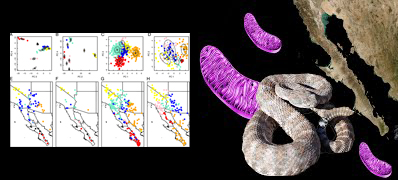Mitochondrial evolution on islandsIslands have played an exceptional role in our understanding of evolution. As such, species that occur on multiple islands offer unique opportunities to examine evolutionary dynamics. We are using a group of New World vipers to understand the impact of insularity on molecular evolution.
Photo credits: Jesse Meik |
Project overview
|
Speckled rattlesnakes include four species (C. angelensis, C. pyrrhus, C. mitchellii, and C. stephensi) that are distributed throughout the southwestern United States and Mexico. They also occur on multiple islands in the Sea of Cortez. Rattlesnakes on these islands are known to exhibit both dwarf and giant body sizes relative to the mainland snakes. Our recent work to understand evolutionary relationships in speckled rattlesnakes involved the sequencing of multiple mitochondrial and nuclear markers. Across three mitochondrial markers we discovered notable rate variation. Island populations explained most of this variation. We subsequently sequenced whole mitochondrial genomes to investigate this phenomenon further.
This project will result in the assembly and analysis of whole mitochondrial genomes from rattlesnakes in order to ask the following questions: Are substitution rates uniform across mitochondrial loci? Are substitution rates uniform across individuals? Do island populations have higher substitution rates? Relevant publications: Meik, J.M., Streicher, J.W., Lawing, A.M., Flores-Villela, O. and M.K. Fujita. 2015. Limitations of climatic data for inferring species boundaries: Insights from speckled rattlesnakes. PLoS ONE. 10(6): e0131435. |
Collaborators |
Jesse Meik - Assistant Professor, Tarleton State University, Stephenville, Texas, USA
Sarah Schaack - Assistant Professor, Reed College, Portland, Oregon, USA Matthew Fujita - Assistant Professor, The University of Texas at Arlington, Arlington, Texas, USA Oscar Flores-Villela - Professor, Universidad Nacional Autonoma de Mexico, Mexico City, MX Daniel Dashevsky - Student, Reed College, Portland, Oregon, USA Longson Pang - MRes student, University College London, London, UK |

